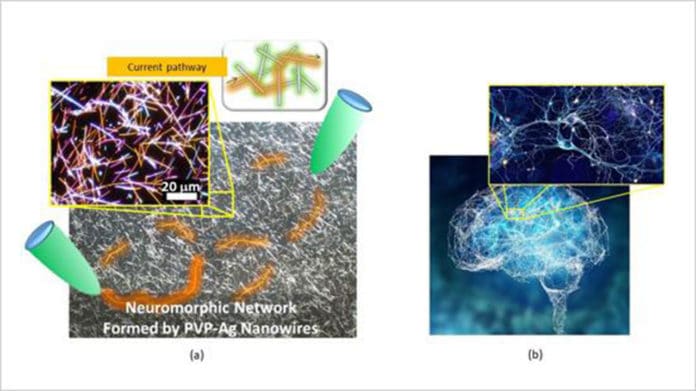Recently, an international joint research team led by NIMS has created a neuromorphic network. Using this network, scientists generated electrical characteristics similar to those associated with higher-order brain functions unique to humans, such as memorization, learning, forgetting, becoming alert, and returning to calm.
Neuromorphic networks are formed by random self-assembly of silver nanowires coated with a polymer layer after synthesis in which junctions between two nanowires act as resistive switches, often compared with neurosynapses.
In this neuromorphic network, there is a junction between two nanowires that later forms a variable resistive element (i.e., a synaptic element) that behaves like a neuronal synapse. This nanowire network contains an enormous number of unpredictably interacting synaptic elements, forms a ‘neuromorphic network.’
When a voltage was applied to the neuromorphic network, it appeared to “struggle” to find optimal current pathways. Scientists then measured the processes of current pathway formation, retention, and deactivation. At the same time, electric current was flowing through the network and found that these processes always fluctuate as they progress, similar to the human brain’s memorization, learning, and forgetting processes.
The observed temporal fluctuations likewise look like the procedures by which the brain becomes more alert or comes back to quiet. Brain-like functions recreated by the neuromorphic network were found to happen as the huge number of synaptic components in the network aggregately work to optimize current transport, in different words, because of self-organized and emerging dynamic procedures.
The research team is currently developing a brain-like memory device using the neuromorphic network material. The team intends to design the memory device to operate using fundamentally different principles than those used in current computers.
For example, while computers are currently designed to spend as much time and electricity as necessary in pursuit of absolutely optimum solutions, the new memory device is intended to make a quick decision within particular limits even though the solution generated may not be optimum. The team also hopes that this research will facilitate an understanding of the brain’s information-processing mechanisms.
